Are you headed to the Louvre and unsure what to see other than the Mona Lisa? The good news is there’s so much more to explore, and we’re here to help. Here are the top things to see at the Louvre.
Pro Tip: Planning to visit the Louvre in Paris? Bookmark this post in your browser so you can easily find it when you’re in the city. Check out our guide to Paris for more planning resources, our top-rated Louvre tours for a memorable trip, and how to visit the Louvre.
Best Things to See at the Louvre Museum in Paris
The Louvre in Paris is a massive museum with one of the most impressive collections in the world. With so much ground to cover and important artwork to see, it can be difficult to know where to start and where to focus your attention.
In this article, we cover the top must-see pieces in the Louvre and where to find them. Here’s our curated list of top 10 artworks that deserve a spot on your bucket list!
- The Winged Victory of Samothrace (Nike)
- Liberty Leading the People
- Psyche Revived by Cupid’s Kiss
- The Coronation of Napoleon
- The Raft of the Medusa
- The Mona Lisa
- The Sleeping Hermaphrodite
- Venus de Milo
- Hammurabi Code
- Great Sphinx of Tanis
Ready to explore? Discover all the intriguing details about each piece as you continue reading.
To find out more about what to see and how to visit the Louvre, explore the menu below:

Watch this video on YouTube
Not ready to book a tour? See if a Louvre Museums tour is worth it.
1. The Winged Victory of Samothrace (Nike)
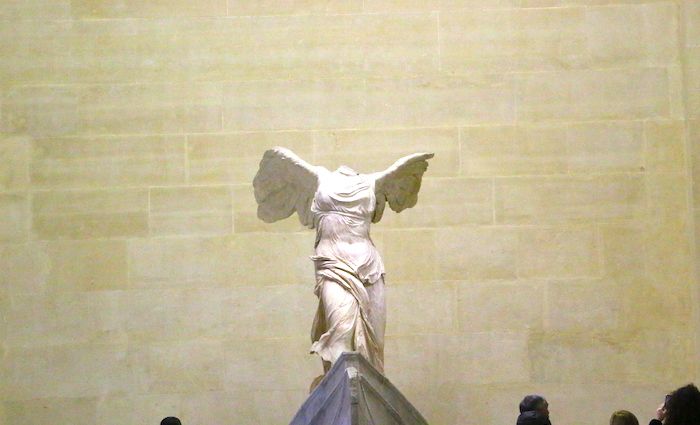

The Winged Victory of Samothrace is, in my opinion, the greatest sculpture in the Louvre, which makes it one of the greatest in history. It is rivaled by few except perhaps the Lacöon Group in the Vatican Museums and David in Accademia. It sits atop the incredible Daru Staircase, adding to its powerful energy.


With intricate detailing, the majestic sculpture looks as though her clothing is billowing in the wind as she stands atop the prow of a ship.
In Ancient Greece, the goddess of Victory was called Nike, which is where the shoe brand takes its name today. It is believed the statue would have been perched powerfully at the prow of a ship.
As you walk up to the statue, make sure to walk up the right side of the stairs if possible, since the statue was created to be viewed from its front-left side.
That’s why if you look at the other side of the statue, the quality of the sculpture is not as refined. It is truly the top thing to see at the Louvre and best seen in person!
Location: Denon Wing, Floor 1, Room 703
2. Liberty Leading the People
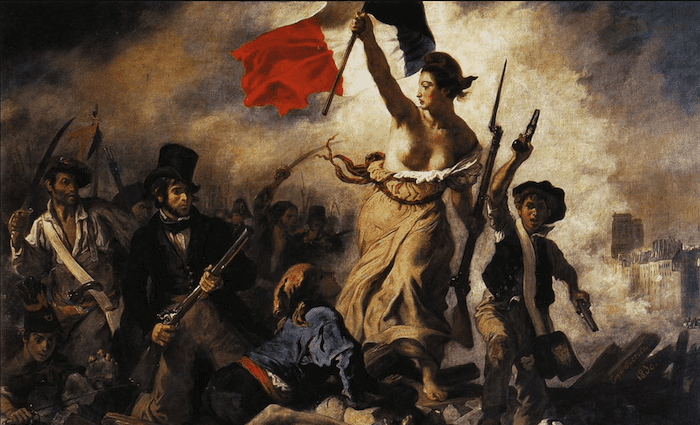

Delacroix is considered one of the greatest romantic painters of French Romanticism. He was the Bernini or Michelangelo of that era. The painting is an allegory of the 1830 revolution.


Liberty is depicted as the bare bosom centerpiece holding the Tricolore flag of France. This was the flag that the militia bore when storming the Bastille. After the revolution, the Tricolore replaced a blue flag with the gold fleur-de-lis, and has been used ever since.
The figure, Liberty, is not unique to this image. She stands in the New York / New Jersey Upper Bay outside of Manhattan. Liberty is famous iconography of ancient Greek origin. Her semi-nude appearance is likely a historical reference to ancient Greece. It would be the same figure as the Winged Victory of Samothrace sculpted 2,000 years earlier.
The figures alongside Liberty represent all classes fighting together. The man in the top hat is a member of the French upper class. In the same line are a factory worker, a student, and other professions alongside one another.
Prior to this painting, Delacroix worked directly for Charles X and depended on him to keep up his lifestyle. He battled internally, working for the enemy.
In a letter to his nephew, he wrote about “dodging bullets the same as the heroes, deposing the enemy.” In another letter to his brother, he wrote, “I have undertaken a modern subject, a barricade, and although I may not have fought for my country, at least I shall have painted for her. It has restored my good spirits.”
Location: Salon of 1831
3. Psyche Revived by Cupid’s Kiss by Antonio Canova
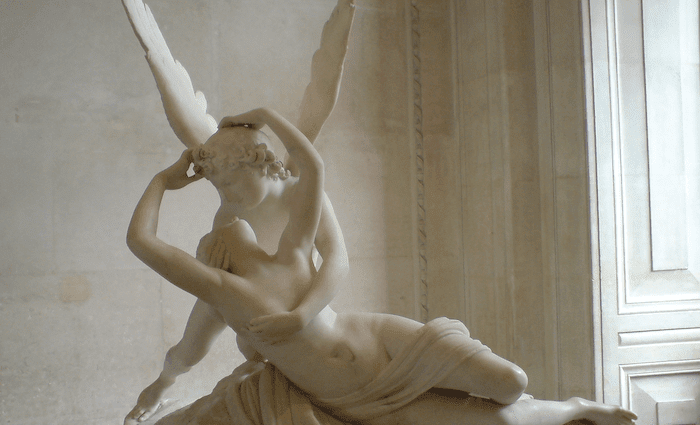

One of the most romantic works of art in the Louvre Museum, Cupid and Psyche is a sculpture that depicts two young lovers in an embrace. Here, the Princess Psyche wakes up for the first time with a kiss from Cupid. The sculpture depicts a story written by Roman poet Lucius Apuleius in the second century A.D.


In the same motion as the above sculpture, Canova created another version of the ancient legend. Proserpina was the unwilling wife of Pluto, the god of the underworld.
Venus, the goddess of love, sent Psyche with a jar to the underworld and have Proserpina fill it up with the secret of divine beauty.
Venus warned Psyche not to look in the jar, but what woman would carry a jar of divine beauty and not take a peek?
Unfortunately for Psyche, the jar was not filled with beauty but with the “Sleep of Innermost Darkness.” Psyche fell into a deep sleep.
Cupid found Psyche asleep with the jar next to her and knew what had happened. His heart was broken, so he took her in his arms to give her one last kiss. Cupid’s kiss of true love revived Psyche, and Canova’s statue adds life to the moment she awakes.
When Canova created this masterpiece, he included a handle on the base of Psyche’s foot to rotate the whole thing. As a result, the movement of the two bodies is an important element of the sculpture, so make sure you walk around the entire piece. Canova reached such fame during his life that they say his funeral rivaled that of Michelangelo in Florence or Raphael’s in Rome.
Location: Richelieu Wing, Room 4, Department of Sculptures.
4. The Coronation of Napoleon
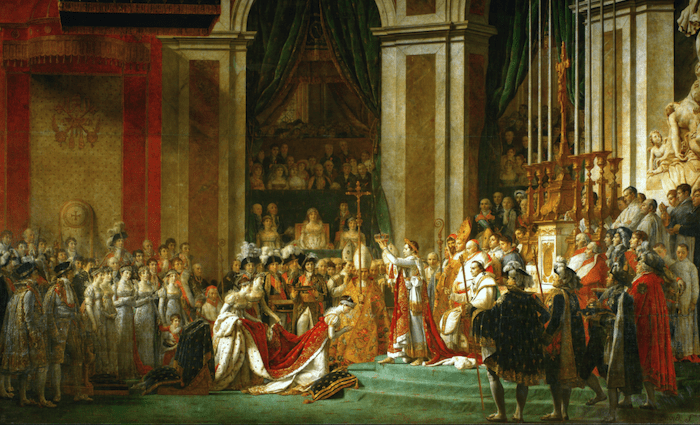

This famous Louvre painting depicts the coronation of Napoleon, which happened in the famous Notre Dame cathedral. After multiple victorious military campaigns in Italy and Egypt, Napoleon took over as the leader of the Empire. The coronation took place on December 2nd, 1804.


Napoleon persuaded the pope to travel from Rome to Paris to bless him as he was named emperor. Napoleon even styled himself after Charlemagne, who was crowned Emperor 1,000 years earlier. Considering that the pope rarely traveled for anyone, his traveling to Paris was a big deal.
Napoleon commissioned painter Jacques-Louis David but gave him precise instructions on how and who should be depicted. With life-like detailing, the painting depicts over 100 individual people.
It is also a Bonaparte family portrait, including his mother, who didn’t even attend since she was against the coronation. Jacques-Louis David not only attended the ceremony but also had multiple attendees pose afterward to obtain their likeness.
At the ceremony, Napoleon took the crown from the pope and placed it on his own head, facing the crowd. Kings respected popes over time because they wanted the pope to crown them. It was of great symbolic importance to get “God’s” approval.
In the painting, however, you’ll see Napoleon crowning the empress. Depicting this part of the scene instead of his own coronation was a nobler gesture. The painting was an instant success, with Bonaparte himself showing his pleasure. David, also fully understanding his own success, said, “I shall slide into posterity in the shadow of my hero.”
Location: Denon Wing, Floor 1, Room 702
Our Best Versailles and Paris Louvre Tours
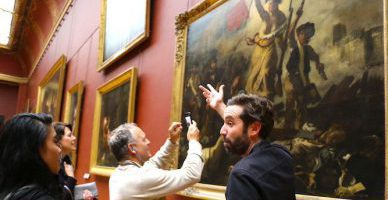


Top-Rated Tour
Secrets of the Louvre Museum Tour with Mona Lisa
The Louvre is the largest art museum on Earth and the crowning jewel of Paris, which is why it’s on everyone’s bucket list. Don’t miss out on an incredible opportunity! Join a passionate guide for a tour of the most famous artwork at the Louvre. Skip-the-line admissions included.

























(236)
See Prices
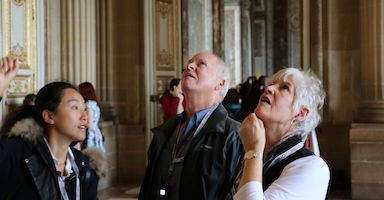

Likely to Sell Out
Skip-the-Line Palace of Versailles and Gardens Tour from Paris
Versailles isn’t that difficult to get to by train, but why stress over the logistics? Meet a local guide in central Paris who will purchase your train tickets and ensure you get off at the right stop. Then enjoy a guided tour of the palace and the unforgettable gardens. Skip-the-line admissions included to the palace and gardens.

























(215)
See Prices
Not ready to book a tour? Find out if a Louvre Museums tour is worth it.
5. The Raft of the Medusa
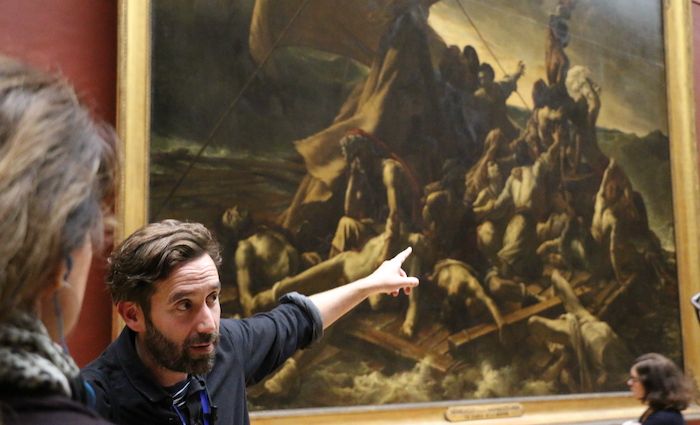

Painted by Théodore Géricault, The Raft of the Medusa depicts the brutal aftermath of a French boat that ran aground in Africa on July 2nd, 1816. The remaining survivors, as many as 150 men, built a raft from the ship’s lumber to save themselves. After almost two weeks, only 10 of the men survived. They endured extreme dehydration, despair, and angst, and even resorted to murder and cannibalism.


The painting depicts not only this tragedy but another horrifying event. A French military ship passed by the raft and did not stop to pick them up. After their rescue, this issue came to light, which started a national drama.
In preparing for the painting, Gericault interviewed at least two survivors. He had them pose for him in order to get the figures as realistic as possible. Gericault also studied corpses to get true representations of the tone and color of dying flesh.
He spent countless weeks creating preparatory drawings from all angles prior to starting what you see today. The painting is on a huge canvas, 16 feet by 23 feet, which makes it even more powerful.
His plan was to release the painting at the Paris Salon of 1819 and create controversy. The relatively unknown 27-year-old artist instantly took center stage as a leading Romantic painter with this masterpiece. His work would influence masters such as Delacroix and Manet.
Location: Denon Wing, 1st floor, Room 700 (Mollien)
6. The Mona Lisa
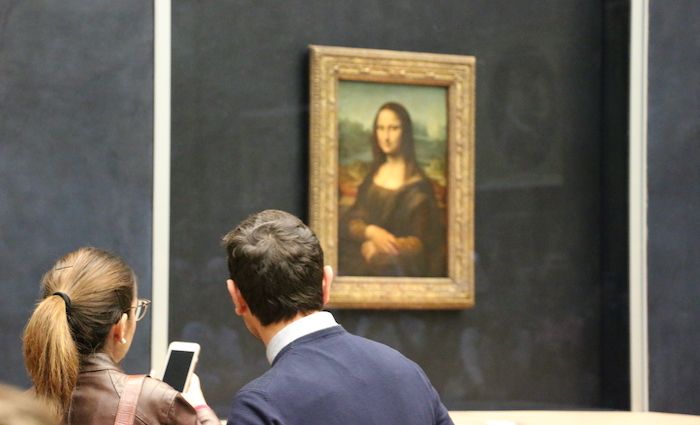

The Mona Lisa by Leonardo da Vinci is undoubtedly the most famous painting at the Louvre Museum and probably in the world. It looks as though she is smiling until you look at her head-on. From this angle, her mouth looks downturned. After the painting’s theft in 1911, pictures of the Mona Lisa appeared in newspapers across the world. If you’ve ever wondered why the Mona Lisa is famous, this is one of the main reasons.
Da Vinci was famous for not finishing his commissions as he was easily distracted. His genius became much more evident as time went on. Some things he had invented were later developed, for example, a diving suit. He was always innovating and trying methods far before his time.


The Mona Lisa is Lisa Gherardini, the wife of wealthy Florentine cloth merchant Francesco Giocondo. Gherardini’s clothes are quite unremarkable, with nothing she’s wearing showing aristocratic status.
Surprisingly, instead of giving the painting to the merchant upon completion, he brought it with him to France. That is why we have it in the Louvre today!
Why number six? The portrait’s fame comes more from it being stolen and da Vinci’s fame than its artistic superiority. It is definitely great, but not the greatest. Da Vinci would likely agree with this since he and other artists used portraits like this to earn money and not to win “awards”.
Location: Denon Wing, Room 711
7. The Sleeping Hermaphrodite
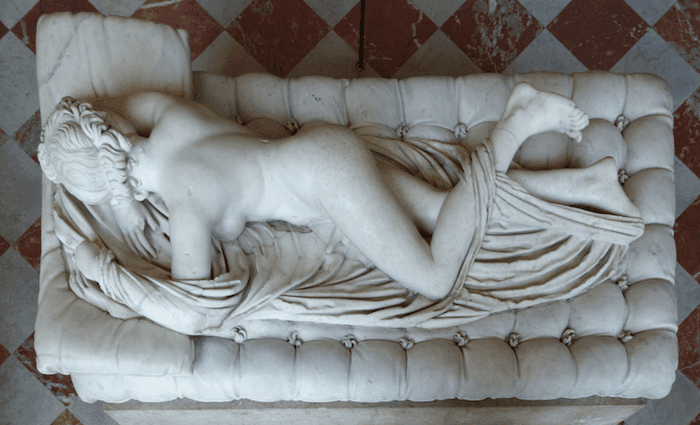

A hermaphrodite, in classical reference, is female in appearance but possesses the “bits and pieces” of a male. Ancient Mediterraneans celebrated and sculpted the hermaphrodite as if she/he were a unicorn today. This can be seen in the hoards of statues dedicated to this sexual being created during antiquity.
There are many anthropological differences between our societies to explain why a hermaphrodite was so celebrated in the past and forgotten in modern times. The Romans and Greeks sculpted this figure with tremendous care, which can be seen in the details.
This particular hermaphrodite is of perfect composition in terms of believability other than the obvious syntax differences. If you walk up from behind, you’ll see what appears to be a beautifully soft woman of practically perfect proportions inviting you into bed with her. Then all of a sudden, surprise, there are some extra parts.
Bernini’s Contribution
The bed was added by Bernini and compliments the sculpture as if they were sculpted together. It’s important to note that the human figure is, without doubt, the most difficult of things to create in an art form. This is because, as humans, we can immediately see if anything is out of proportion. The first step is getting the proportions right.
After that, you need to make the composition human-like. The elements of the sculpture appear soft to the touch. This is complemented by the robe wrapped around her/him, which is 100% the same material but appears to be different.
Location: Sully Wing, Floor 1, Room 348 (Salle des Caryatides)
8. Venus de Milo
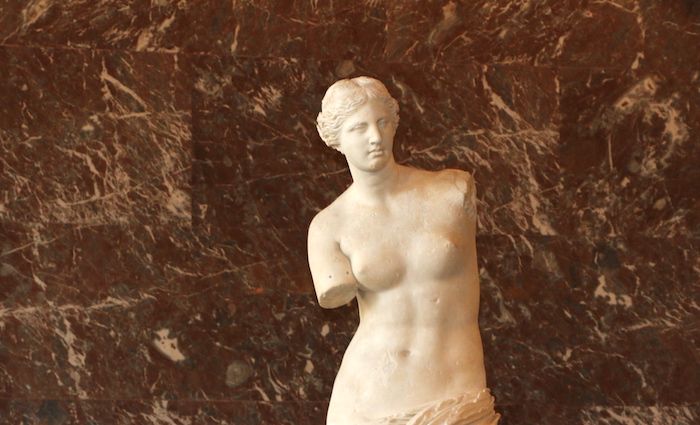

With a captivating backstory, Venus de Milo dates back to around 100 B.C. Unearthed in 1820, the ancient Greek statue came from the island of Melos. It likely depicts the goddess Venus who represents love, beauty, sex, and fertility.


While the name is “Venus” today, it may not be the goddess Venus at all. First of all, Venus is a Roman goddess and not a Greek goddess. Aphrodite was the Greek goddess of love, and thus her name should be Aphrodite de Milo.
That said, it may not even be Aphrodite since there is very little symbolism without her arms. It could be Amphitrite, who was deified as a goddess on the island of Melos (Milo).
The sculptor is also a mystery. Praxiteles may be able to take credit for the masterpiece, but this is not certain. Many believe the sculptor is Alexandros of Antioch, who lived in the second century B.C. Regardless, the marble statue is celebrated for its Hellenistic artistry.
The mystery behind who she is and who brought her to life, coupled with her charms, attracts attention. The intrinsic beauty of her face is undeniable.
Location: Sully Wing, Floor 1, Room 346 (Parthenon Room)
Already in Paris? Purchase tickets and tours for the hottest destinations!
Not ready to book a tour? See if Paris tours are worth it.
9. Hammurabi Code
A well-preserved Babylonian code of law of ancient Mesopotamia, the Code of Hammurabi dates back to about 1754 B.C. (Middle Chronology). King Hammurabi, the sixth Babylonian King, originally enacted the law, which is why it bears his name. It may not be the most impressive stone art in the Louvre, but it’s an incredible piece of history.


Hammurabi was the King of Babylon and ruled from 1792-1750 B.C. The Hammurabi Code is the most important legal code from the ancient Middle East. It is older than the biblical laws of Christianity. The stele consists of 280 laws and deals with various problems and situations of Ancient Babylonia.
It is the shape of an index finger and measures 7.5 feet (2.5 meters). On top, you can see the figure of the god Shamash presenting the code to Hammurabi himself. The material came from Magan in Sumeria, the modern United Arab Emirates, and Oman.
Discovered in 1901 and translated the following year, it is written in the Akkadian language through the cuneiform script and broken up into three main parts. The first two parts basically praise Hammurabi as the protector of the “weak and oppressed.”
The third part includes the actual laws themselves. The longest chapter of laws speaks about engagement, marriage, divorce, adoption, adultery, incest, inheritance, and the duties of children’s nurses.
Location: Richelieu Wing, Floor 1, Room 227, Mésopotamie.
10. Great Sphinx of Tanis
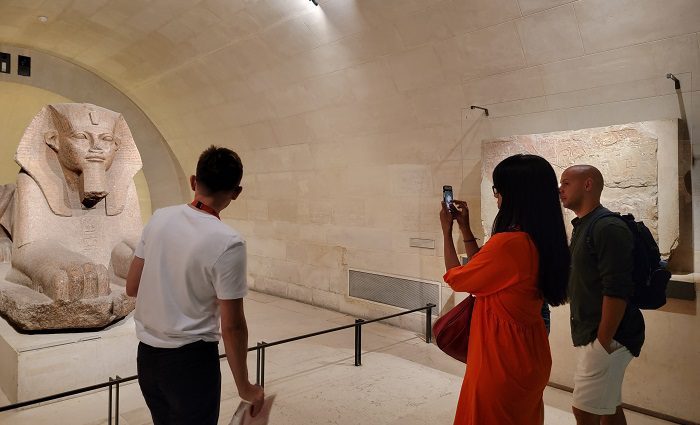

The Great Sphinx of Tanis also goes by the name “the guardian of the Louvre Museum.” Found in Tanis, Egypt’s capital during the 21st and 23rd Dynasties, she is one of the largest sphinxes you can find outside Egypt.


Impressive to look at, the Great Sphinx of Tanis was discovered in 1825 among the ruins of the temple of Amun in Tanis. The claws are outstretched to give the impression that she’s ready to pounce on you! An interesting fact about this sphinx is that it’s difficult to date accurately.
It seems that after the original construction, the following pharaohs decided to replace their predecessors’ names with their own. They scratched out the original text and replaced it as generations went on.
Today, you can see the following: Ammenemes II (12th Dynasty, 1929 – 1895 B.C.), Merneptah (19th Dynasty, 1212 – 02 B.C.), and Shoshenq I (22nd Dynasty, 945 – 24 B.C.). For this reason, egyptologists range its “birth” from the 4th (2613 to 2494 B.C.) to the 12th Dynasty (1991 B.C. – 1783 B.C.).
The word “sphinx” is a Greek word signifying the close relationship between the sun god Ra (the lion’s body) and the king (the human head). The actual word in Egyptian would have been shesep-ankh, which signifies a living image. The statue’s position symbolizes it as a protector of Egypt against any foreign intruders.
Location: Sully Wing, Floor 1, Room 338, Crypt of the Sphinx.

Watch this video on YouTube
Not ready to book a tour? Find out if Paris tours are worth it.
Popular Paris Tours


Best-Selling Tour
Paris Catacombs Tour with Secret Rooms & Privileged Access
The Paris Catacombs are unlike most attractions you can visit since it’s an underground burial ground with 6 million skeletons adorning the walls. Learn the deep history here with our English-speaking guide for an experience of a lifetime. Skip-the-line admissions and access to exclusive areas that the public can’t access make this the best tour of the Paris Catacombs.






















(64)
See Prices



Top-Rated Tour
Secrets of the Louvre Museum Tour with Mona Lisa
The Louvre is the largest art museum on Earth and the crown jewel of Paris. You could spend days here, but instead, join a passionate, English-speaking guide for a tour of the most famous artworks. View the Mona Lisa, the Coronation of Napoleon, Winged Victory of Samothrace, and so much more.

























(236)
See Prices
Not ready to book a tour? Check out our best Paris tours to take and why.

Watch this video on YouTube


Where To Stay in Paris
With a city as magnificent as Paris, it can be hard to find the perfect hotel at the perfect price. Explore the best hotels and places to stay in these incredible neighborhoods in Paris.

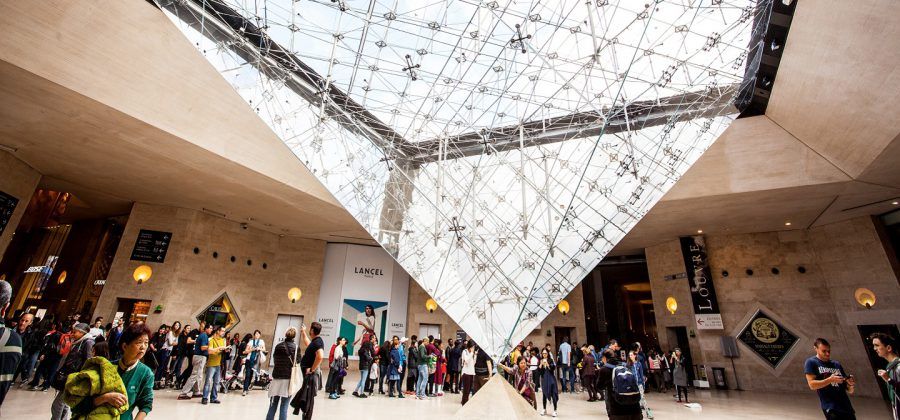



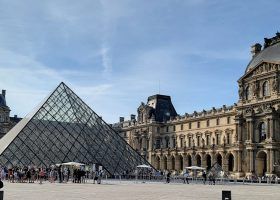
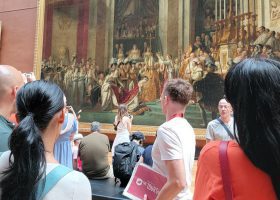


Top Ten things to See at the Louvre Museum – Map Itinerary Included
I am interested in this tour around May 24th.
I cant find a link to pay for this. Please help
Bonjour! Thanks for reading! Unfortunately, our day tours for the Louvre are full on May 24th. We still have availability for the Louvre Under the Stars Evening Tour that begins at 6:45PM. If you have any questions, please reach out to our travel experts via chat or phone. tel:+18882905595
very nice guide. i love the maps;)